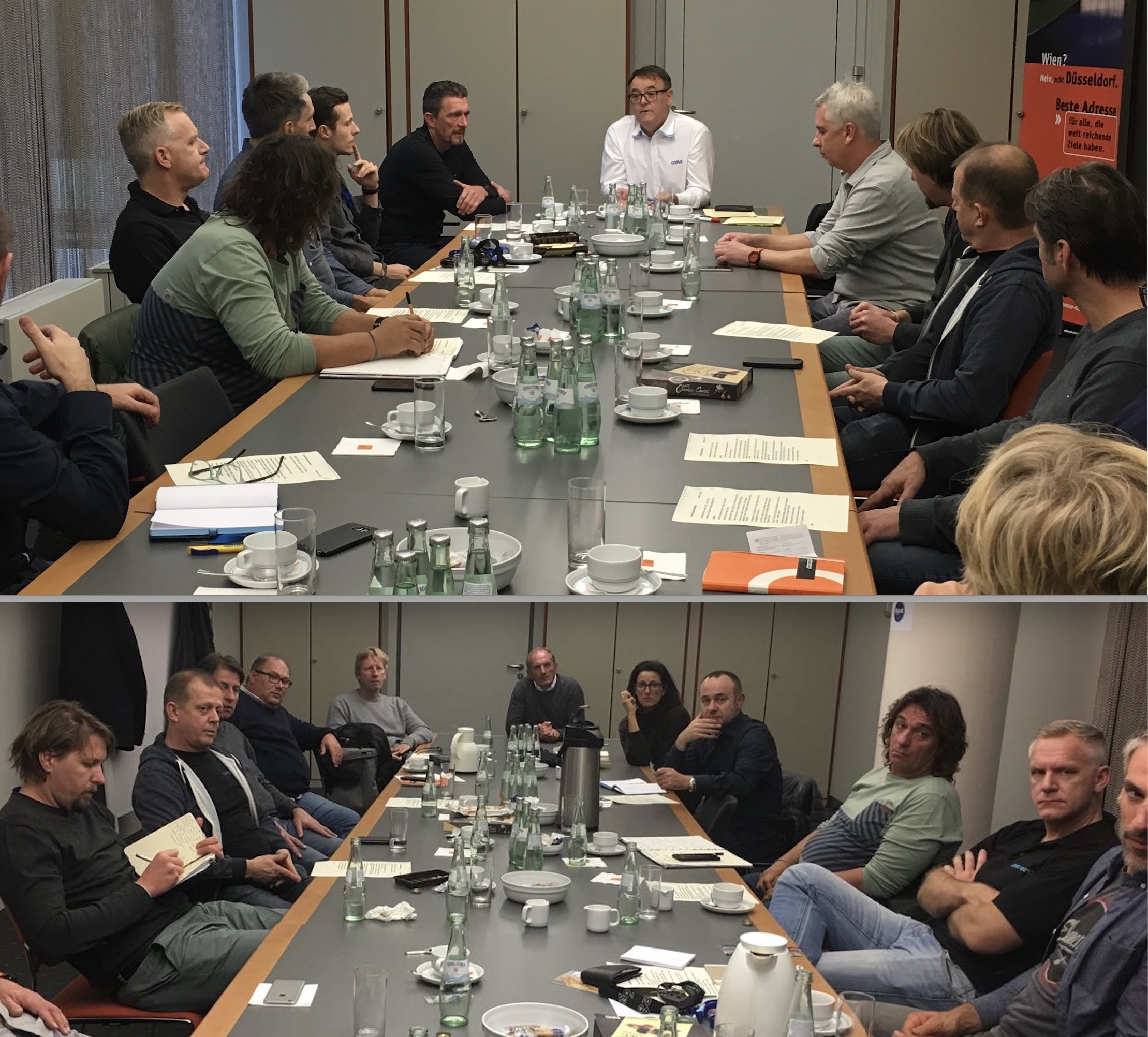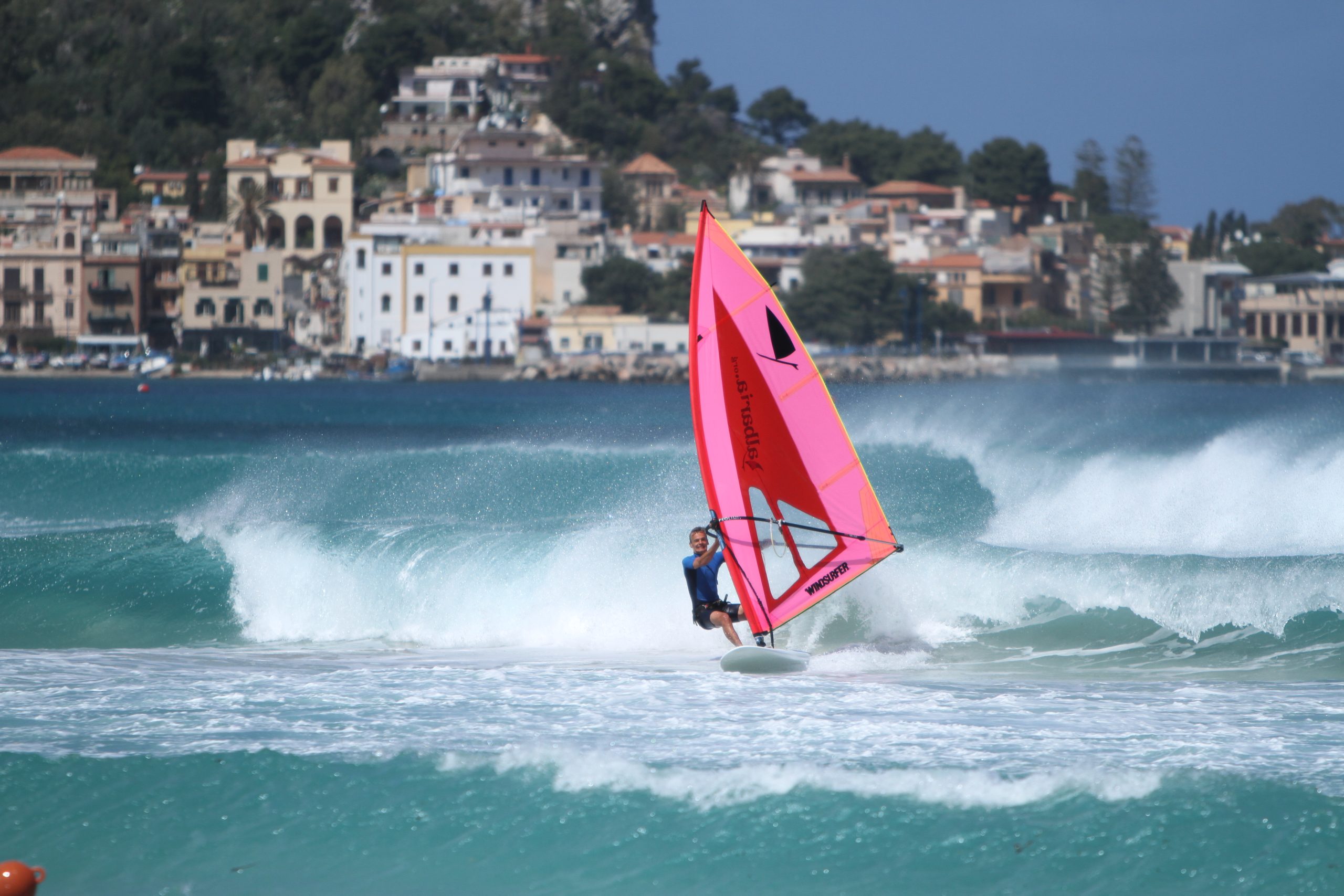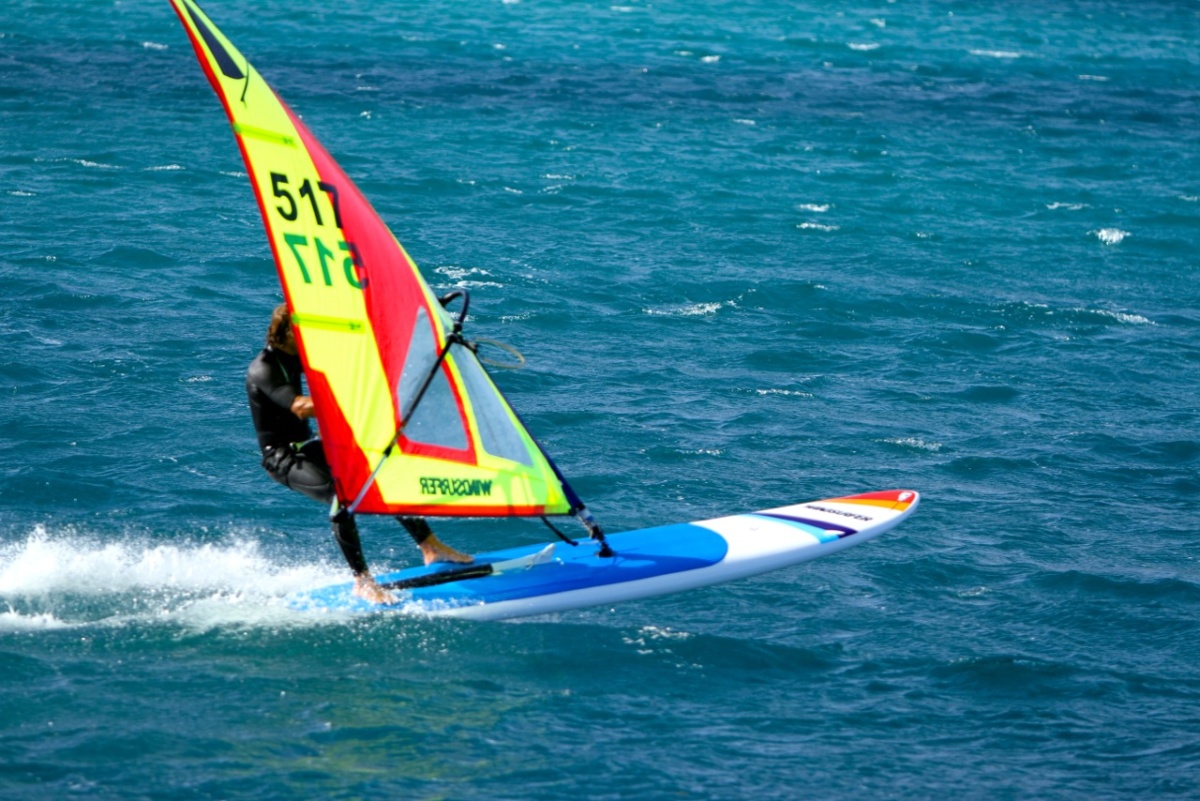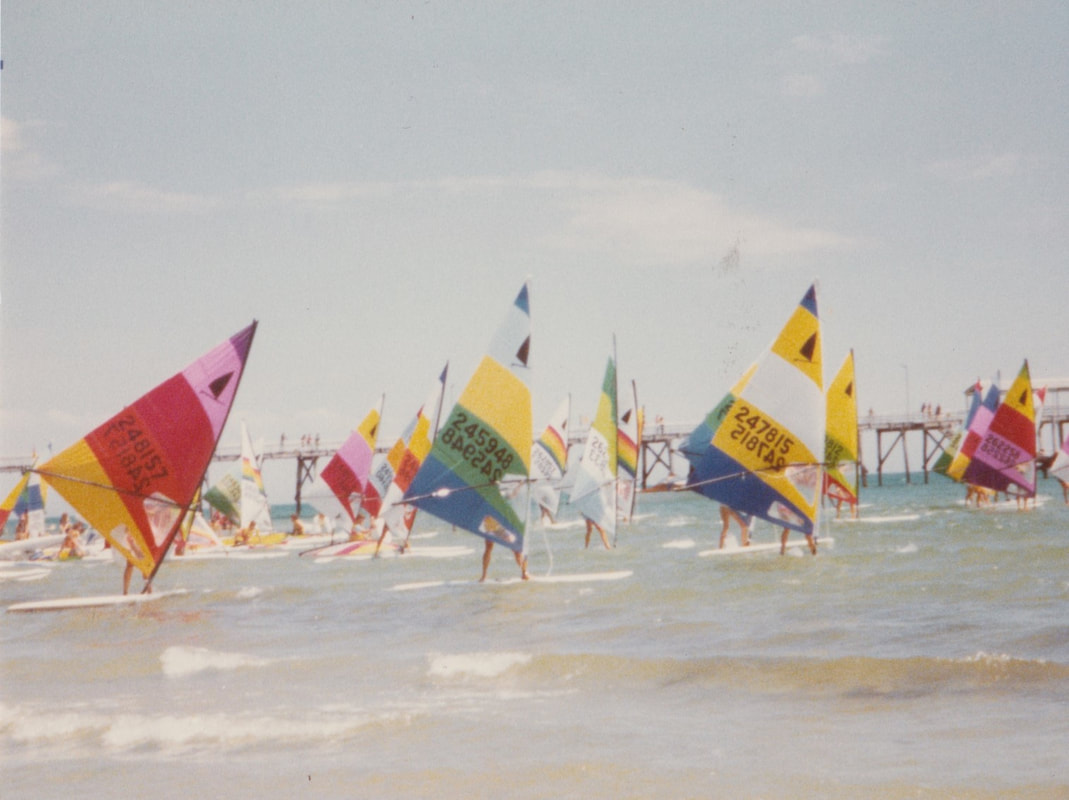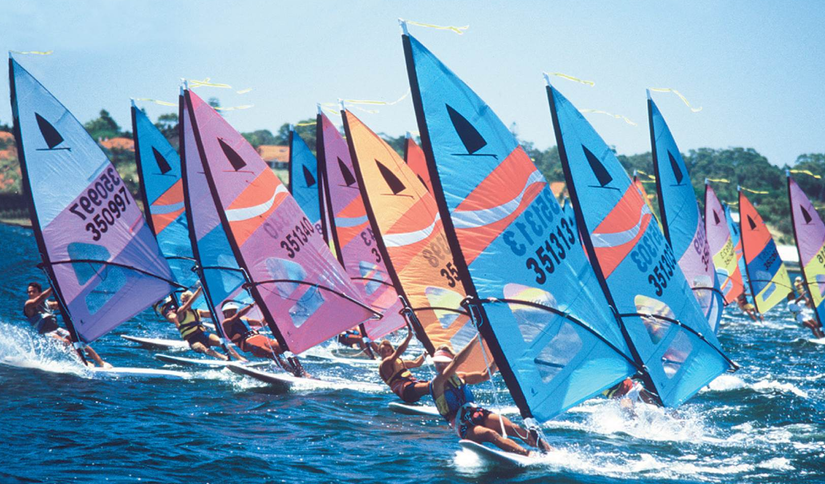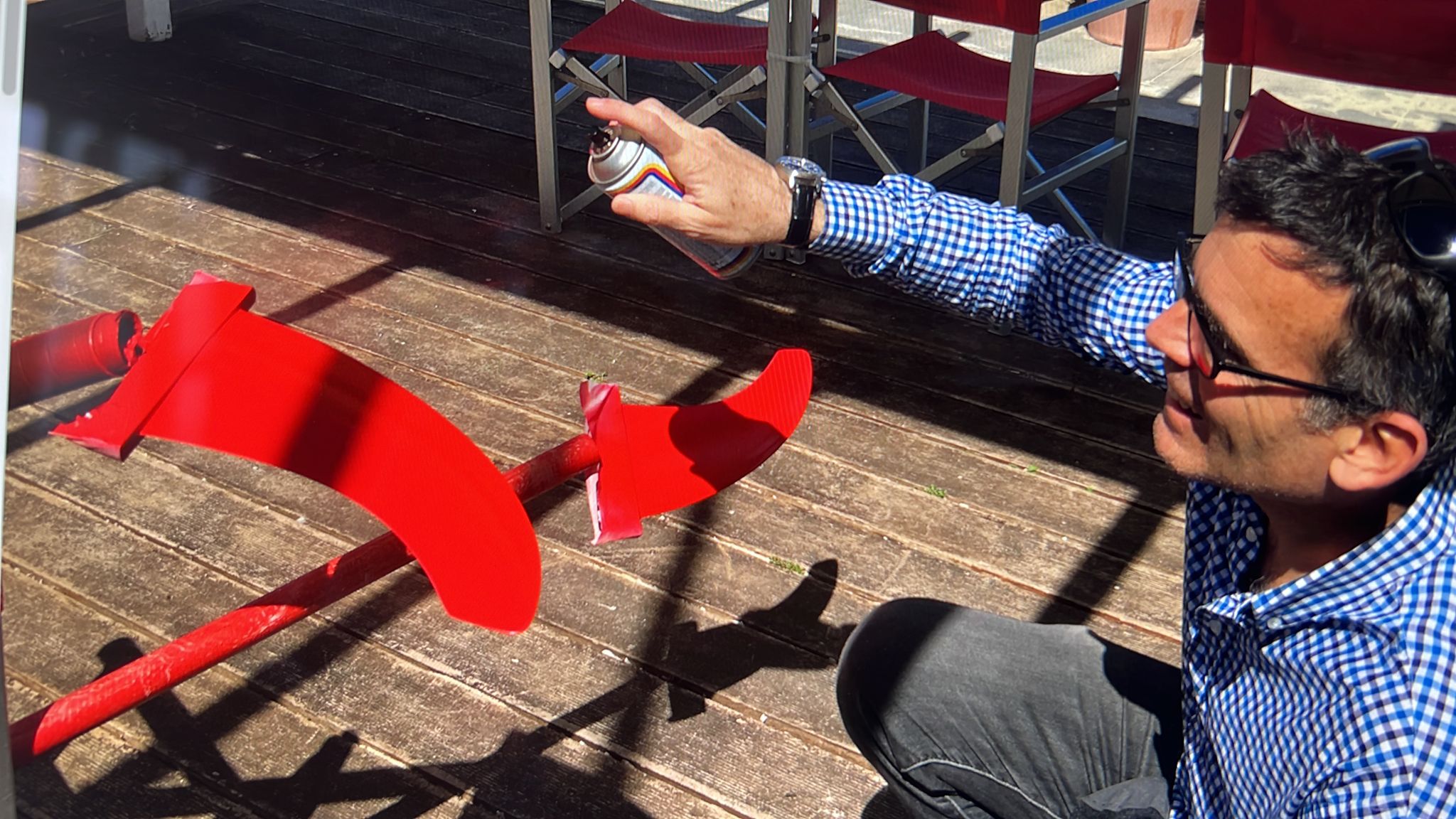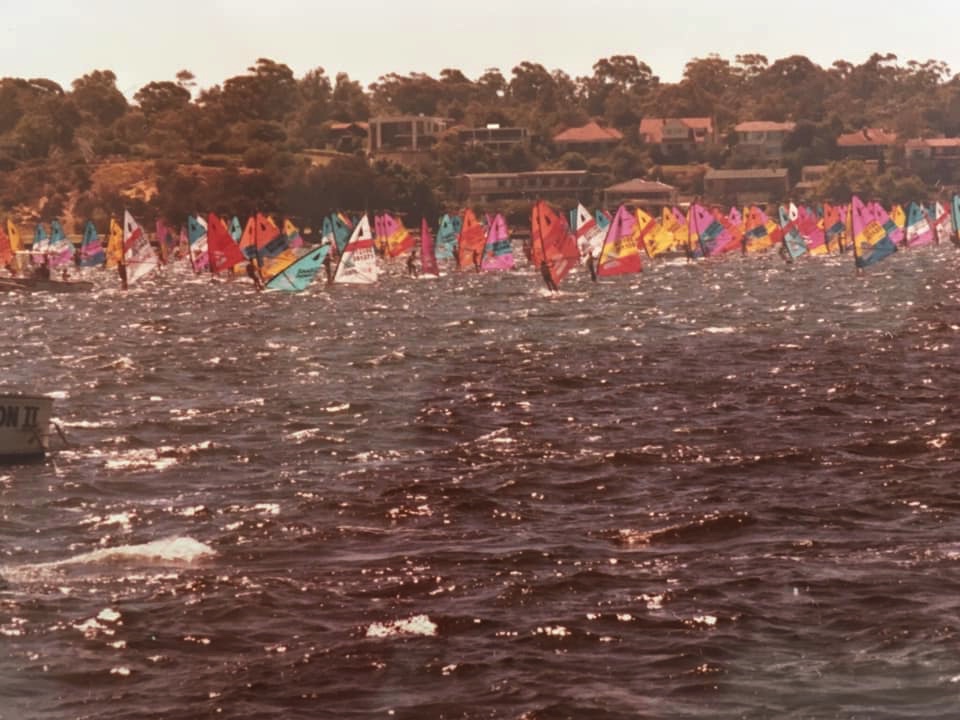“A futuristic vehicle for your dreams has risen out of the western sea, bringing new dimensions to life itself. How can such a simple, easy-rider device bring so much joy to millions? Because …it puts you – with your skills and your dreams and your hidden potential – into a perfect interaction with wind and water. Thus, this one small vehicle brings with it the power to make your visit here on planet earth even more fulfilling.”
Hoyle (1984)
The history of the Windsurfer Class
The first sailboard recognized by a court of law was a board built in the summer of 1958 by 12 year old Peter Chilvers on Hayling Island, England. He stood on a shaped plank and steered it with a rudder and tiller. When his rudder broke off on a windy day, he discovered he could steer by rotating the sail fore and aft by holding on to the boom. At the end of the summer he stowed the board in a shed and it was later discarded.
A second free sail system was created in the mid-‘60’s by American Newman Darby. While his “board” had a mast attached by a rope to the board in a simple free-sail system, it lacked a wishbone boom, which made it difficult to sail in windy and gusty conditions, since the sailor had to keep his back to the wind. Attempts at marketing the craft proved unsuccessful, as only two hundred boards were sold.
The first “Windsurfer Class” board was born in 1967 thanks to Jim Drake, a sailor and aeronautic engineer, and Hoyle Schweitzer, a surfer and computer pioneer. In 1968 Schweitzer and his wife Diane founded the company Windsurfing International in Southern California to manufacture, promote and license a windsurfer design made from polyethylene. Drake, heavily involved in designing advanced military aircraft, decided not to partner with Schweitzer to sell the craft.
Sales for Windsurfer were slow the first few years when, in 1972, Dutch textile executive Martin Spanjer saw Hoyle windsurfing in Marina Del Rey, CA. He thought he might be a good customer for his company’s sailcloth. After a few months of negotiations, Schweitzer licensed Ten Cate Sports to produce and market the Windsurfer in Europe.
Since its invention windsurfing has passed its fifty years anniversary and it is 48 years ago since its official recognition by the World Sailing Federation (IYRU) in 1973. A mere 35 years ago, the professional World Cup started and the sport made its debut at the Olympic Games of Los Angeles of 1984. However the first international sport events started with the Windsurfer Class, a “One Design” class with the same board and sail for all competitors.
The ‘Windsurfer’ was the original mass-produced sailboard and instantly gained world-wide attention which quickly spawned the massive growth and popularity of the sport. The Original Windsurfer was a strict one design (1968 – 1984) wich sold over 400.000 units, still the largest sailing class ever.
The class activities started in the USA and Europe in 1973, the first international Windsurfer regatta took place in France in 1974 Italy followed in 1975 and Australia in 1976 where 456 competitors took part in what was then the largest one design sailing event ever. With the competitors assigned into different divisions according to their weight and gender, fleet sizes became more manageable and kept the competition fair for heavier sailors.
Throughout the late 70’s and 80’s the Windsurfer Class was king for amateur sailboarding racing around the world with international and national events attracting the large fleets.
In the early eighties Sailboarding became an Olympic yachting class and the 1984 Olympics included the Windglider sailboard division as well as demonstration events on the Windsurfer One Design. In the same year the “Windsurfer One Design” was launched with an updated Mylar sail and rig. The board also sported footstraps stiffer fin and a partially retracting centre-board. These changes made the One Design much more controllable in stronger winds than its predecessor. Later in the year, the Windsurfer One Design World Championships were held in Perth (sponsored by Coca Cola), Western Australia, with over 350 competitors.
Even if the evolution of windsurfing took different ways in the late eighties, nineties and after the turn of the century, the Windsurfer Class kept its traditional way of regatta sailing.
Throughout the 80’s, 90’s and 200’s the One Design was raced widely, however towards the end of this period, the One Design fleet started to dwindle whilst the sport was growing exponentially. By 2010 fleet sizes were reduced but strong pockets still existed with Australia and Italy continuing to attract good fleets and conducting regular racing at a National level.
On 25 June 2015 on the occasion of the OPEN RSX European Championships organized by Albaria in Palermo, Vincenzo Baglione and Carlo Dalla Vedova (the two who together with Maurizio Bufalini and Luca Frascari had kept the Windsurfer class alive in Italy by making use of the import of polyethylene boards from ‘Australia) invite Bruce Wylie to Palermo, who has become the head of Cobra international for which Riccardo Giordano, who moved to Thailand, will start working.
Carlo, Bruce and Manu Messian (Neyl Pryde) discuss and deepen the simple project of Vincenzo and of which Riccardo Giordano and Bruce Wylie will concretely study the effectiveness so that Cobra will make the first prototypes in 2016. Bruce and Riccardo begin to test the prototypes in Pattaya to define a board useful for the experts of the Windsurfer Class but also usable for beginners, an economical board, and with a material other than polyethylene. A white “White board” to be made on the basis of the characteristics of the historic Windsurfer, revised and corrected (also thinking about the Mistral Competition model) and which could be sold by the most prestigious brands in the world.
It is history that the birth of the Windsurfer with other boards, including Mistral and the opening of the various schools not only in the sailing clubs but in various beaches around the world, have brought thousands of fans closer to sailing in general. With the proliferation of amateurs and agonists, all the sailing federations have benefited from it (which thanks to the new sport have enormously increased the number of members) to the benefit of all sailing activities.
Bruce Wylie and Vincenzo Baglione meet in Sydney on the occasion of the 40th anniversary of the Open Championships, the involvement of the Windsurfer Australia class takes place successfully and the meeting of 26 January 2017 – in the Balmoral Sailing Club kitchens – with Greg Jones will lead to the decision to stop the production of the old polyethylene boards not only for the better future of the windsurfer class, but to regenerate the Windsurfing Community at that time in crisis all over the world.
While Cobra collects all the information to create the Windsurfer LT “Multibrand” (thanks to Bruce Wylie, Riccardo Giordano, Vincenzo Baglione, Greg Jones and Edoardo Thermes) – on the other – the three Windsurfer classes Australia, Italy and Japan will take action to support the project thanks to their members (100 Italians , 100 Australians and 100 Japanese) who agreed to buy – paying in advance – the boards even before they were made by Cobra which had received the consent of the Schweitzer family.
On the occasion of the Dusseldorf International Show (22 January 2018) a meeting was held organized by Bruce Wylie of Cobra – which took place with all the major companies in the Windsurfing sector – Vincenzo Baglione and Celine Bordier – presented and highlighted the importance of the project Windsurfer LT which thanks to Cobra have joined the companies Starboard, Gastra, Naish, Exocet, I-99 by Cesare Cantagalli and later other brands.
Over the last decade it became even one of the most popular windsurfing classes in Italy and Australia where in 2019 not less than the 45th and 44th National Championships took place. International racing took off again in 2017 in Barcelona (Spain), with the so-called Eurocup, with 80 entries from 7 European nations.
In 2018 the Windsurfer Class lived its major turnaround. In March the new Windsurfer LT was launched and accepted by the members of the Windsurfer Class.
In July the World Trophy on Lake Garda was its first success with 103 competitors from 12 nations, followed in September by the Italian championship in Sardinia with 102 participants. In October, the Spanish championships and Eurocup were held with 52 entries. In November of the same year, the Windsurfer Class received its official recognition by World Sailing and this success could be celebrated in December during the Siam Cup in Thailand. Well over 90 entries from 14 Nations and 4 Continents; among them 12 Olympic athletes including 2 gold and 1 bronze medalists.
2019 started with the Australian championships with 107 athletes at the start and during the year the Class even further accelerated its ascend. Classes were founded again in traditional Windsurfer countries like France and the Netherlands and thanks to the recognition of World Sailing the first World Championships were held again on Lake Garda in July, but this time with a record participation of 180 competitors. In September the Italian Championships took place in Vieste, followed by the European and Dutch Championships in October in the Netherlands, where the first big event of the local newborn Class attracted well over 120 athletes from 12 nations.
Hoyle and Diane Schweitzer, the couple behind the birth of the sport, not only started off regatta racing on the Windsurfer, but at the same time introduced a new way of life that today we consider as being the “Windsurfer Spirit”.
The future for the Windsurfer Class is positive and exciting.



